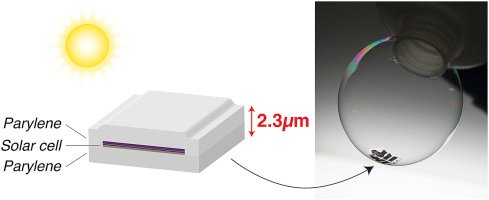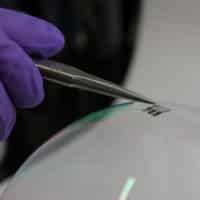This solar cell is so light, it can be placed on a soap bubble – it’s just a fraction of the thickness of a human hair.
Researchers at MIT developed the proof-of-concept solar cells with view to ultimately helping to power the next generation of portable devices.
A common flexible polymer called parylene was used for the substrate and overcoating. The compound is commonly used to protect biomedical devices such as pacemakers and printed circuit boards.
The primary light absorbing layer is an organic material called .. wait for it:
dibenzo{[f,f′]-4,4′,7,7′-tetraphenyl}diindeno[1,2,3-cd:1′,2′,3′-lm]perylene
.. thankfully it’s also known by the much friendlier term, DBP
This thinner than wafer-thin solar cell is quite green in terms of production. The process is entirely carried out in a vacuum chamber at room temperature and no solvents are required.
The substrate and the solar cell itself are formed using vapor deposition techniques; which are able to form extremely thin layers of material. Parylene films of thicknesses of up to 80 microns can be deposited easily using commercial equipment. 80 microns is in the region of the diameter of a human hair – so much thicker than this cell.

A flexible parylene film around the tenth the thickness of plastic food wrap is first deposited on glass, then the solar cell and followed by another layer of parylene.
The final solar cell is one-fiftieth of the thickness of a human hair and is so light that if you were to breathe on it, the cell would blow away.
Being extremely flexible, more useful versions of this solar cell could be directly applied to or deposited on just about anything, including clothing.
An interesting comparison is the solar cell demonstrated an output of 6 watts per gram — about 400 times higher than conventional solar panels.
As to the future of the technology:
“We have a proof-of-concept that works,” said MIT professor Vladimir Bulović. The next question is, “How many miracles does it take to make it scalable? We think it’s a lot of hard work ahead, but likely no miracles needed.”
It seems the Stanford team’s creation is almost an order of magnitude thinner and lighter than the previous record holder.
The process is detailed in a paper by Professor Bulović, research scientist Annie Wang and doctoral student Joel Jean, in the journal Organic Electronics.







































